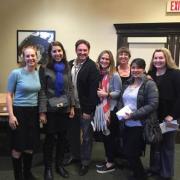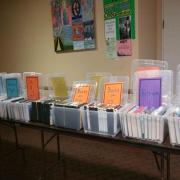Los Angeles Public Library recently launched a pilot program to offer library services to homebound patrons. We partnered with ONEgeneration Senior Center and Menorah House, a low-income senior housing facility. A committee of librarians and community partners worked together to plan and implement a service to bring the library to patrons who were unable to visit it.
The Senior Book Stop allows seniors to browse a selection of books and check out materials. It first took place in January 2016 and will occur on a monthly basis, alternating at ONEgeneration Senior Center and Menorah House. An additional component is the Book Delivery Service, which piggybacks on the meal delivery service offered by the senior center.
Advanced Planning
Since our library system was not able to offer services to homebound patrons on its own, I was hoping to partner with a community organization that could be the link between the library and the patron. My goal was to start a pilot program that could be replicated in other areas of Los Angeles.
The two community partners we identified — ONEgeneration Senior Center and Menorah House — became the library’s partners for the pilot program. This was a critical step in the process, as they had similar goals and a volunteer base. Our community partners distributed a survey to gauge the level of interest in the service (View the interest survey under Attachments at right.), and librarians and partners spent one year brainstorming how to make this idea a reality.
Marketing
To promote the pilot program among the populations we were trying to reach, the committee created fliers explaining the new service in the main languages spoken by this population, which are English, Russian and Farsi. (View the multi-language Senior Book Stop fliers under Attachments at right.) At Menorah House, staff advertised the upcoming service via posters and fliers that were slipped under the residents’ doors. ONEgeneration Senior Center used fliers, its website and a newsletter that goes out to 5,000 community members.
Budgeting
We didn’t spend more than $250 on the cart, bins, signage and incidentals. Luckily, we already had a tablecloth and a wireless router and tablet for issuing library cards.
Day-of-event Activity
Two librarians and a few volunteers were present at the Book Stop location. They unloaded the materials from their cars and used a flat cart to haul it inside. Bins filled with books and audiobooks were set up on tables in the lobby and signage was placed where needed. Then the seniors were encouraged to browse.
The book delivery program was integrated into an existing meal delivery program led by the ONEgeneration Senior Center. The driver began by bringing each of the seniors a library card application, plus a survey asking which genres they enjoyed, any particular authors they like, and whether they needed large-type/books on CD/etc. The completed applications and surveys were forwarded to a librarian, who issued a "homebound library card" for that individual and also selected appropriate reading materials for them based on their surveys. Senior center staff held onto the library cards so they could check out the materials before handing them over to the delivery route drivers.
Program Execution
The Senior Book Stop remained at each location for approximately two hours. Visitors were enthusiastic about the opportunity to have the library come to them. Librarians chatted with the seniors who stopped by, issued a number of library cards and checked out materials. We were very pleased with the results.
The Book Delivery Service component was a big success as well; we started with one route and immediately increased it to two. Seven seniors used the service for the first time, and we expect it to grow over time. The Senior Book Stop and Book Delivery Service programs will take place every eight weeks at each location.
Judging by the programs' strong start, we think they will prove to be popular and lasting. The goal is to inspire librarians in the other regions of Los Angeles to try this themselves!
Advice
Start by getting permission from administration to try a pilot like this one, and then research community partner options. The Health and Wellness Committee of the Encino Chamber of Commerce (a community within L.A.) allowed me to speak at a meeting about my idea, and that’s where I found my first community partner. Then the committee ended up bringing in the second partner — so network in the relevant organizations in your city.
Supporting Materials
- Feedback (Coming Soon!)
- Programming Librarian Facebook Group




